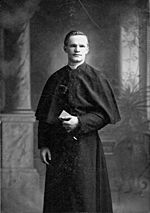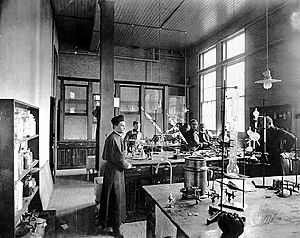Julius Nieuwland facts for kids
Quick facts for kids The Reverend Julius Aloysius Arthur Nieuwland CSC |
|
|---|---|

Young Julius Nieuwland
|
|
| Orders | |
| Ordination | 1903 |
| Personal details | |
| Born | 14 February 1878 Hansbeke, Belgium |
| Died | 11 June 1936 (aged 58) Indiana, United States of America |
| Buried | Cedar Grove Cemetery near Notre Dame |
| Alma mater | University of Notre Dame, The Catholic University of America |
Julius Aloysius Arthur Nieuwland (born February 14, 1878 – died June 11, 1936) was a Belgian-born Catholic priest. He was also a professor of chemistry and botany at the University of Notre Dame in Indiana, USA.
Father Nieuwland is famous for his important work with acetylene. This research helped create a type of synthetic rubber. His discoveries eventually led to the invention of neoprene, a special kind of rubber developed by the company DuPont.
Early Life and Discoveries
Julius Nieuwland's parents moved from Hansbeke, Belgium, to South Bend, Indiana, in 1880. As a young man, Julius went to the University of Notre Dame. There, he studied Latin and Ancient Greek and earned his first degree in 1899.
Soon after, he began studying to become a priest. He was ordained as a priest in 1903. Then, Nieuwland went to graduate school at The Catholic University of America. He focused on botany (the study of plants) and chemistry.
During his studies, he researched the chemistry of acetylene. He discovered a chemical compound called lewisite. This chemical was later used in warfare. Nieuwland himself became sick and had to go to the hospital for several days after touching the new compound. He did not continue to study it further.
Teaching and Research
After getting his PhD in 1904, Nieuwland returned to Notre Dame. He taught botany until 1918. After that, he became a professor of organic chemistry until 1936.
In 1909, Father Nieuwland started a science magazine called American Midland Naturalist. He was the editor of this magazine until 1934.
A big achievement came in 1920. Nieuwland successfully changed acetylene into a material called divinylacetylene. This basic research was very important. Elmer Keiser Bolton, who was a research director at DuPont, used Nieuwland's findings. This research helped DuPont develop neoprene, a very useful synthetic rubber.
Father Nieuwland passed away when he was 58 years old. He was buried at the Community Cemetery near Notre Dame.
One of Nieuwland's well-known students was Knute Rockne. Rockne later became a very famous football coach at Notre Dame. Rockne earned a degree in pharmacy from Notre Dame in 1914. He then taught chemistry at Notre Dame from 1915 to 1922, while also coaching sports.
Awards and Recognition
Julius Nieuwland received many honors for his scientific work:
- Morehead Medal from the International Acetylene Association (1932)
- President of the Indiana Academy of Sciences
- American Institute of Chemists Gold Medal (1935)
- Nichols medal (1935) for his work on making new materials from hydrocarbons
- Mendel Medal from Villanova University (1936)
When scientists write about plants, they use the short name Nieuwl. to show that Julius Nieuwland named or described a plant.
In 1996, Father Nieuwland was honored by being added to the National Inventors Hall of Fame. He is the only Catholic priest to receive this special honor.
See also
 In Spanish: Julius Aloysius Arthur Nieuwland para niños
In Spanish: Julius Aloysius Arthur Nieuwland para niños
- List of Roman Catholic scientist-clerics
- List of National Inventors Hall of Fame inductees


